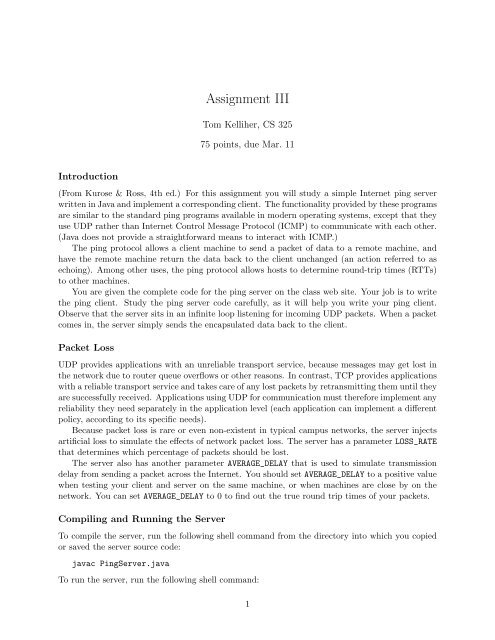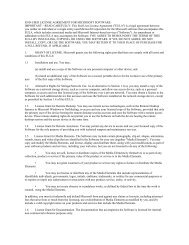Assignment III - Phoenix Goucher
Assignment III - Phoenix Goucher
Assignment III - Phoenix Goucher
You also want an ePaper? Increase the reach of your titles
YUMPU automatically turns print PDFs into web optimized ePapers that Google loves.
Introduction<br />
<strong>Assignment</strong> <strong>III</strong><br />
Tom Kelliher, CS 325<br />
75 points, due Mar. 11<br />
(From Kurose & Ross, 4th ed.) For this assignment you will study a simple Internet ping server<br />
written in Java and implement a corresponding client. The functionality provided by these programs<br />
are similar to the standard ping programs available in modern operating systems, except that they<br />
use UDP rather than Internet Control Message Protocol (ICMP) to communicate with each other.<br />
(Java does not provide a straightforward means to interact with ICMP.)<br />
The ping protocol allows a client machine to send a packet of data to a remote machine, and<br />
have the remote machine return the data back to the client unchanged (an action referred to as<br />
echoing). Among other uses, the ping protocol allows hosts to determine round-trip times (RTTs)<br />
to other machines.<br />
You are given the complete code for the ping server on the class web site. Your job is to write<br />
the ping client. Study the ping server code carefully, as it will help you write your ping client.<br />
Observe that the server sits in an infinite loop listening for incoming UDP packets. When a packet<br />
comes in, the server simply sends the encapsulated data back to the client.<br />
Packet Loss<br />
UDP provides applications with an unreliable transport service, because messages may get lost in<br />
the network due to router queue overflows or other reasons. In contrast, TCP provides applications<br />
with a reliable transport service and takes care of any lost packets by retransmitting them until they<br />
are successfully received. Applications using UDP for communication must therefore implement any<br />
reliability they need separately in the application level (each application can implement a different<br />
policy, according to its specific needs).<br />
Because packet loss is rare or even non-existent in typical campus networks, the server injects<br />
artificial loss to simulate the effects of network packet loss. The server has a parameter LOSS_RATE<br />
that determines which percentage of packets should be lost.<br />
The server also has another parameter AVERAGE_DELAY that is used to simulate transmission<br />
delay from sending a packet across the Internet. You should set AVERAGE_DELAY to a positive value<br />
when testing your client and server on the same machine, or when machines are close by on the<br />
network. You can set AVERAGE_DELAY to 0 to find out the true round trip times of your packets.<br />
Compiling and Running the Server<br />
To compile the server, run the following shell command from the directory into which you copied<br />
or saved the server source code:<br />
javac PingServer.java<br />
To run the server, run the following shell command:<br />
1
java PingServer <br />
where is the port number the server is to listen on. Remember that you have to pick a port<br />
number greater than 1023, because only processes running with root (administrator) privilege can<br />
bind to ports less than 1024.<br />
Your Job: The Client Program<br />
You should write the client so that it sends 10 ping requests to the server, separated by approximately<br />
one second. Each message contains a payload of data that includes the keyword PING, a<br />
sequence number, and a time stamp. After sending each packet, the client waits up to one second<br />
to receive a reply. If one second goes by without a reply from the server, then the client assumes<br />
that its packet or the server’s reply packet has been lost in the network. Hint: Cut and paste<br />
PingServer.java, rename the code PingClient.java, and then modify the code.<br />
You should write the client so that it starts with the following shell command:<br />
java PingClient <br />
where is the FQDN of the computer the server is running on and port is the port number<br />
it is listening to. Note that you can run the client and server either on different machines or on the<br />
same machine.<br />
The client should send 10 pings to the server. Because UDP is an unreliable protocol, some of<br />
the packets sent to the server may be lost, some of the packets sent from server to client may be<br />
lost, or packets may be received out of order. For this reason, the client can not wait indefinitely<br />
for a reply to a ping message. You should have the client wait up to one second for a reply; if no<br />
reply is received, then the client should assume that the packet was lost during transmission across<br />
the network. You will need to research the API for DatagramSocket to find out how to set the<br />
timeout value on a datagram socket.<br />
When developing your code, you should run the ping server on the same machine that the<br />
client runs on. merlin.goucher.edu, for example. After you have fully debugged your code, you<br />
should see how your application communicates across the network with a ping server run on another<br />
machine. phoenix.goucher.edu, for example.<br />
Message Format<br />
The ping messages in this lab are formatted in a simple way. Each message contains a sequence of<br />
characters terminated by a carriage return character (’\r’) and a line feed character (’\n’). The<br />
message contains the following string:<br />
PING CRLF<br />
where starts at 0 and progresses to 9 for each successive ping message sent by<br />
the client, is the time when the client sent the message, and CRLF represent the carriage<br />
return and line feed characters that terminate the line.<br />
Client Output<br />
For each message returned within its one second window, print its sequence number and the RTT.<br />
For each timed-out packet, prints its sequence number and the string Timed out. For each packet<br />
received out of sequence, print the sequence number of the received and expected messages and<br />
the string Message received out of order. Before terminating, your program should report the<br />
minimum, maximum and average RTTs.<br />
2
Administrivia<br />
1. If you want to write you client in a language other than Java, check with me FIRST.<br />
2. Your source code must be appropriately documented. This will count as a significant part of<br />
your grade. Spelling and grammar matter.<br />
3. Your client code must be emailed as an attachment to kelliher[at]goucher.edu by the<br />
beginning of class on the due date.<br />
4. Your client code will be tested by running it on merlin, with the Java ping server running on<br />
phoenix. You should assume that I will set LOSS_RATE and AVERAGE_DELAY to various fairly<br />
nasty values in order to torture your client program. I will be looking for graceful behavior,<br />
and evidence of intelligent design decisions, at the limits of the client’s performance.<br />
5. I am already aware that a working PingClient.java is available on at least one web site. I<br />
consider merely viewing any such source code, regardless of implementation language, to be a<br />
violation of the Honor Code. In a similar vein, although I encourage you to discuss concepts<br />
with each other, I prohibit you from sharing any code with each other. Again, any violation<br />
of this policy is a violation of the Honor Code.<br />
Extra Credit<br />
The basic program sends a new ping immediately when it receives a reply. For 10 points of extra<br />
credit, modify the program so that it sends exactly 1 ping per second, similar to how the standard<br />
ping program works. Hint: Use the Timer and TimerTask classes in java.util. In order to receive<br />
the extra credit, your program’s documentation must clearly indicate that this feature has been<br />
implemented. No extra credit will be given if any of the base program’s functionality is missing.<br />
3










